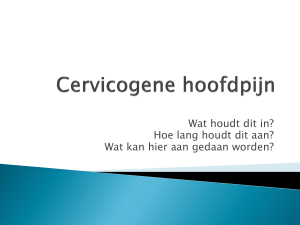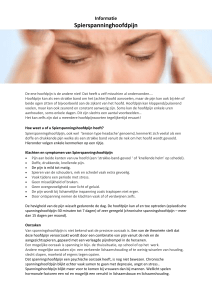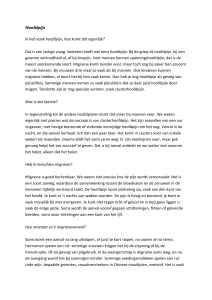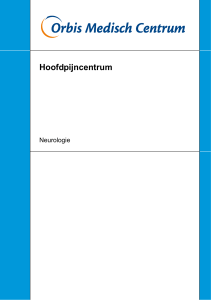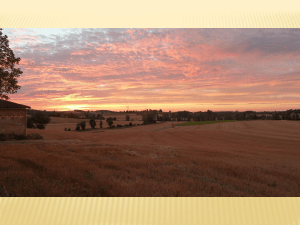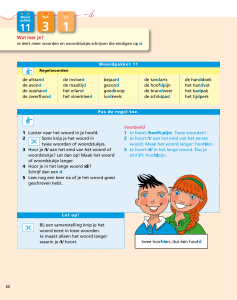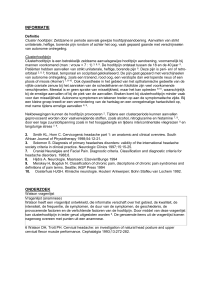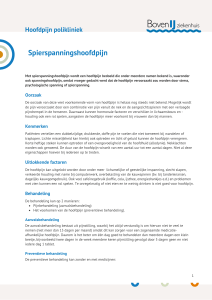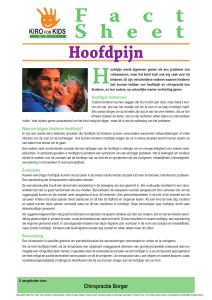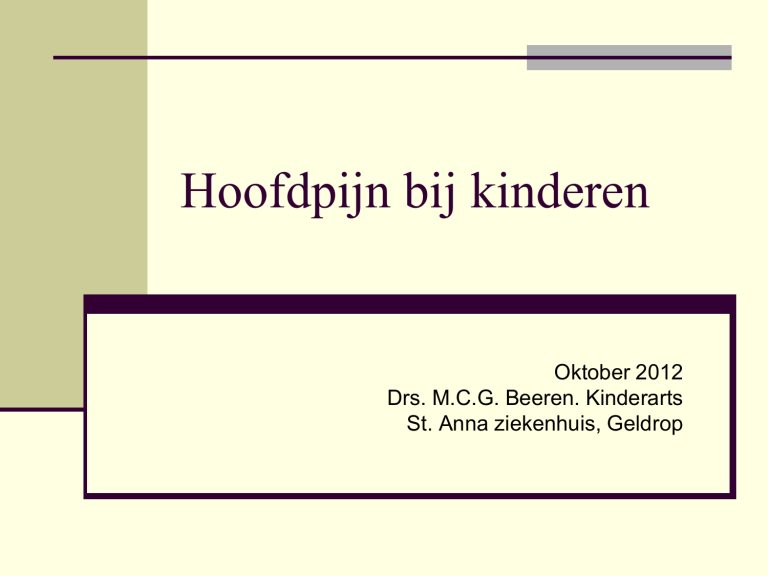
Hoofdpijn bij kinderen
Oktober 2012
Drs. M.C.G. Beeren. Kinderarts
St. Anna ziekenhuis, Geldrop
Inhoudsopgave
Epidemiologie
Algemene aanpak hoofdpijn
Kinderen met hoofdpijn
Multidisciplinair carrousel
Behandeling:
Medische factoren
Psychologische factoren
Algemene adviezen
Medicatie misbruik
Inhoudsopgave (vervolg)
Proefschrift J. Bruijn
Kwaliteit v leven
Psychologische/psychiatrische comorbiditeit
Take home messages
Epidemiologie
Primaire hoofdpijn1
Lifetime prevalentie: 97%
Prevalentie laatste jaar: 92%
Prevalentie afgelopen week: 47%
Prevalentie dag: 24%
Secundaire hoofdpijn2
15-20% jonge patienten met klacht hoofdpijn
Epidemiologie II
Migraine3:
1 jaars prevalentie: 11%-17%
Spanningshoofdpijn (SSH)3:
1 jaars prevalentie: 9,8%-23%
Algemene aanpak hoofdpijn bij de
kinderarts
Aanpak
Anamnese,
Lichamelijk onderzoek
Aanvullend onderzoek
Diagnose
beleid
Anamnese
Eerste kind zelf, evt tekening
Hoe, wanneer ontstaan
7 dimensies
Familieanamnese
Eerdere behandelingen
Visus,
Leefstijl
…
Lichamelijk onderzoek
Algemeen pediatrisch onderzoek
Orienterend neurologisch onderzoek
En….
Hoofdpijndagboek
Onderscheid primair vs secundair
Primaire hoofdpijn ip behandelen
aanvalsbehandeling vs profylaxe
Secundaire hoofdpijn
Onderliggende oorzaak zoeken en
behandelen
Maar bij beiden:
onderliggende, versterkende en
instandhoudende factoren behandelen!
Primaire hoofdpijn
* migraine
- zonder aura
- met aura
* spanningshoofdpijn
* chronische spanningshoofdpijn
* clusterhoofdpijn
ALTIJD CONFORM ICHD II CRITERIA
!
ICHD criteria migraine
(volwassenen!)
A. 5 aanvallen voldoen aan criteria B-D
B. Duur: 4-72 uur
C. 2 van onderstaande karakteristieken:
– unilaterale lokatie
– Pulserende hoofdpijn
– Matig tot ernstige pijn
– Verergering of uitlokking bij lichamelijke activiteit
D. Gedurende de hoofdpijn 1 symptoom:
– Misselijk en/of overgeven
– Fotofobia en fonofobia
E. Niet door een andere ziekte
Verschil met volwassenen
kortere duur aanval: 1-72 uur
vaak bilaterale hoofdpijn (82,7%)
Fases migraine
Prodromale fase
Aura
Hoofdpijn
herstel
Aanvullend onderzoek
Op geleide van aanwijzingen,
alarmsymptomen
evt lab, beeldvorming, icc (oogarts)
Prodromen:
Geestesgesteldheid /Neurologisch /Algemeen
Neerslachtig, Hyperactief
Euforisch,Spraakzaam
Prikkelbaar,Suf
Rusteloos,Fotofobie
Fonofobie,Concentratiestoornis
Dysfasie,Hyperosmie
Geeuwen,Stijve (Pijn) nek
Trek in bepaald voedsel,sloomheid
Anorexie,Koud gevoel
Diarree of constipatie
Dorst,Urinelozing,Vochtretentie
Aura:
In 20%, ontstaan in 5-20 minuten; duur <60’’
Visueel
Positief (gevolgd door negatief)
Centraal rand (of andersom)
Alle kleuren (geen wit)
Sensibel
Tintelingen (gevolgd door
gevoelloosheid)
Motorisch
Parese of afasie, vaak combi sensibel
Hoofdpijnfase
• bonzende hoofdpijn
• anorexie
• misselijkheid, braken
• slaperig, gapen
• fotofobie, fonofobie, osmofobie
• duur: 4-72 uur
Herstel
Kan opvallend snel
Behandeling
Leefstijl
Aanvalsbehandeling
Profylaxe
Pijnstilling cfr richtlijn nvk
http://www.nvk.nl/DeNVK/Documenten.aspx?Command=Core_Downlo
ad&EntryId=674
ICHD criteria
Spanningshoofdpijn
Hoofdpijn met 2 van de volgende kenmerken
Bilateraal aanwezig
Drukkend/klemmend (niet kloppend)
Mild tot matig intensiteit
Geen toename met fysieke activiteit
Geen misselijkheid of braken
Overgevoeligheid voor licht of geluid of geen
van beide
Duur vanaf 30 minuten.
Behandeling
Analgetica
Leefstijladviezen
Ontspanningsoefeningen
….
Alarmsymptomen bij kinderen (1)
Occipitaal en of in de nek gelocaliseerd:
ruimte innemende afwijking, vaak in de
achterste schedelgroeve
Hoofdpijn waar het kind in de nacht van of in
de ochtend mee wakker wordt:
ruimte innemende afwijking
Hoofdpijn in de nacht of ochtend gepaard gaande
met misselijkheid en of braken:
ruimte-innemende afwijking
Alarmsymptomen bij kinderen (2)
• Per-acuut ontstane hoofdpijn (thunderclap)
• Voorgeschiedenis: maligniteit, afweerstoornis
• Systemische klachten: koorts, stijve nek,
huiduitslag
• Focale neurologische klachten of afwijkingen bij
lichamelijk onderzoek
• Stollingsstoornissen
• Leeftijd < 5 jaar
Secundaire hoofdpijn
* hoofdpijn tgv hoofd/nek trauma
* hoofdpijn tgv cervicale/craniële vasculaire
aandoeningen
* hoofdpijn tgv niet-vasculaire intracraniële
aandoeningen
* hoofdpijn tgv overmatig medicijn- of drugs-gebruik
* hoofdpijn tgv infectie
* hoofdpijn tgv verstoringen milieu interieur
* hoofdpijn tgv aandoeningen van schedel, nek, ogen,
oren,sinussen, tanden, mond of andere structuren
van schedel of nek
* hoofdpijn tgv psychiatrische aandoeningen
Onderscheid primair vs secundair
Primaire hoofdpijn ip behandelen
aanvalsbehandeling vs profylaxe
Secundaire hoofdpijn
Onderliggende oorzaak zoeken en
behandelen
Maar bij beiden:
onderliggende, versterkende en
instandhoudende factoren behandelen!
Kinderen met hoofdpijn
Qol:
Depressie, angst en slaapstoornissen
Predisponerende factor6
Gevolg van hoofdpijn7
Schoolverzuim: 41% over jaar1
Qol kinderen met kanker8
Volwassenen:
Migraine bij kinderen >50% volwassen leeftijd9
Kinderen met hoofdpijn
Moeilijk bij kinderen goed te diagnosticeren
Vooral jonge kinderen moeilijk klachten
beschrijven
Veel beïnvloedende factoren spelen mee
Precipiterende factoren
Predisponerende factoren
Verergerende factoren
Praktijk kinderarts St Anna
Geldrop
Doorverwezen door huisarts naar kinderarts
Anamnese
LO/ KNO
Evt aanvullend onderzoek
Dagboek, hoofdpijn checklist
CBCL lijsten
Aanvalsbehandeling, behandeling herkende
onderliggende ziekten.
Multidisciplinaire carrousel
Onderzoek
Retrospectief statusonderzoek
WESP studente H. Stael, Universiteit Maastricht
november 2009-mrt 2010, nu arts
jeugdgezondheidszorg)
157 patiënten
Kinderarts/Fysiotherapeut/
Psycholoog/pedagogisch medewerker
behandeling hoofdpijn gerelateerde
factoren:76,44% goede/betere uitkomst
First visit pediatric outpatient
clinic: 285 (100%) patients
182 patients (63,86%)
met inclusion criteria for
the carousel
14 patients
(4,91%):
complaints
disappeared
before date
carousel
7 patients
(2,46%)
were not
interested to
go through
the carousel
4 patients
(1,4%) did
not want to
see a
specific
member of
the team
157 patients
(55,09%)
went
through the
carousel
103 (36,14%)
were excluded
from this study
91 patients
(31,93%) did
not meet
the inclusion
criteria for
carousel
3 patients
(1,05%)
were
admitted at
another
hospital
9 patients
(3,16%)
were
admitted at
St. Anna,
Geldrop
Multidisciplinaire carrousel II
Kinderarts
Pedagogisch
medewerker
Kind
met hoofdpijn
Fysiotherapeut
Psycholoog
Age at carousel
Number of patients (%)
30
25
20
15
10
5
0
<3
3 -< 5
5-<7
7- < 9
9 - < 11
Age (Years)
11 -< 13
13- < 15
>/ 15
Duration of the headaches
30
Number of patients
25
20
15
10
5
0
0
10 20 30 40 50 60 70 80 90 100 110 120 130 140 150 160 170 180 190
Duration in months
Number of patients (%)
Age start headaches
25
20
15
10
5
0
<3
3 -< 5
5-<7
7- < 9
9 - < 11 11 -< 13 13- < 15
Age (Years)
>/ 15
not
specified
Frequency of headaches
10,19%
10,83%
Daily (D)
49,04%
Weekly (W)
Monthly (M)
Variable (V)
29,94%
Pain intensity score 1-10
No
information
available
9- </10
8- <9
7- <8
6- <7
5- <6
4- <5
3- <4
2- <3
1- <2
Number of patients (%)
Pain intensity
45
40
35
30
25
20
15
10
5
0
School absence
44,59%
55,41%
School absence
No school absence
Comorbid symptoms
no
comorbid
nausea
dizziness
vomiting
stomach
ache
fotofobia
eye
symptoms
tiredness
fonofobia
fainting
pyrosis
tingling of
arm
osmofobia
Number of patients (%)
Prevalence of comorbid symptoms
45
40
35
30
25
20
15
10
5
0
Usage of pain medication
12,74%
12,10%
7,64%
No pain medication usage
Paracetamol
NSAID
Combination of PCM + NSAID
67,52%
Usage other headache related medication
11,46%
2,55%
Migraine medication
2,55%
Antiepileptics
Both antiepileptic + migraine
medication
None
83,44%
Number of patients (%)
Additional treatment programs tried prior to carousel
90
80
70
60
50
40
30
20
10
0
No additional
therapies
1 therapy
2 different
therapies
3 different
therapies
4 different
therapies
5 different
therapies
Other therapies prior to carousel
Total number of patients
Regular
Subdivision
Physiotherapy
Manual therapy
Caesar therapy
Mensendieck therapy
Psychological consultation
Podotherapy
Other physician
Haptonomy
Alternative
Acupuncture
Osteopathy
Foot reflexology
Orthomolecular therapy
Chiropractic therapy
Homeopathy
Kinesiology
therapy
No additional therapies
1 therapy
2 different therapies
3 different therapies
4 different therapies
5 different therapies
N
% (n=34)
34
35
8
7
2
5
7
3
2
1
21
2
9
2
1
2
3
1
1
123
23
3
6
1
1
% (n=157)
21,66
23,53
20,59
5,88
14,71
20,59
8,82
5,88
2,94
5,1
4,46
1,27
3,18
4,46
1,91
1,27
0,64
5,88
26,47
5,88
2,94
5,88
8,82
2,94
2,94
1,27
5,73
1,27
0,64
1,27
1,91
0,64
0,64
67,65
8,82
17,65
2,94
2,94
78,34
14,65
1,91
3,82
0,64
0,64
Medical contributors
No additional
cause
Changes in
medication
Need for
binoculars
Allergies
Sinusitis
Menstruation
Viral
meningitis
Eardrum
tubes
Lactose
intolerance
Asthma
Number of patients (%)
Evaluation by the pediatrician during the carousel
80
70
60
50
40
30
20
10
0
Medical contributors
No additional
cause
Changes in
medication
Need for
binoculars
Allergies
Sinusitis
Menstruation
Viral
meningitis
Eardrum
tubes
Lactose
intolerance
Asthma
Number of patients (%)
Medische factoren
Evaluation by the pediatrician during the carousel
80
70
60
50
40
30
20
10
0
Physiotherapeutical contributors
No additional
cause
Cervical rotation
defects/movement
restrictions
Bad posture
Stiffness/tension
Trigger point
therapy
Number of patients (%)
Evaluation by the physiotherapist during the carousel
60
50
40
30
20
10
0
Contributors
Nothing
wrong
Drink more
Sleep
improvement
Eat
more/more
regular
Medication
Structure
Less caffeine
Psychological
comorbidity
Fear of failure
Number of patients (%)
Evaluation by the pedagogic fellow worker during the carousel
30
25
20
15
10
5
0
Bijdrage psychologie
Wanneer is hoofdpijn ontstaan
Groep 2 groep 3 ?
Overgang groep 8 middelbare school?
Stress op school/thuis etc.
IQ?
Faalangst?
Perfectionisme?
Etc.
Psychologische factoren
Psychological contributors
Nothing
wrong
Stressors at
school
Stressors in
general
Personality
Psychiatric
comorbidity
40
35
30
25
20
15
10
5
0
Stressors at
home
Number of patients (%)
Table 15: Evaluation by the psychologist during the carousel.
Stressors
Too
difficult/overburden
Fear of failure
General
Dyslexia
Under stimulation
Bullied
Too easy
Need of a stable
environement
Number of patients (%)
Stressoren op school
Stressors at school
16
14
12
10
8
6
4
2
0
Behandeling kinderen met hoofdpijn
Adviezen naar aanleiding van
multidisciplinaire carrousel
Behandelbare oorzaken secundaire
hoofdpijn
Vaak anamnestisch
geen
aanwijzingen voor
binoculars
Outcome with
oogafwijkingen
Belangrijke oorzaak hoofdpijn
25%
Behandeling goed resultaat!
Good result
No result
75%
Adviezen op psychologisch gebied
Op zoek naar stressoren
Aanpakken mbv ouders en school
Sovatraining? Weerbaarheidstraining?
Etc.
Algemene adviezen bij hoofdpijn
Drinken:
min. 1.5 liter/dg
Geen cola/ice tea/caffeine
Eten:
Regelmaat
Voldoende
Bijvoorbeeld: specifieke voedingsmiddelen,
cave…
Algemene adviezen bij hoofdpijn
Slapen
Voldoende slaap overeenkomstig leeftijd
Structuur thuis
Stoppen gebruik pijnmedicatie
Number of patients (%)
5
0
Contributors
Nothing
wrong
Drink more
Sleep
improvement
Eat
more/more
regular
Medication
Structure
Less caffeine
Psychological
comorbidity
Fear of failure
Algemene adviezen
Advices
30
25
20
15
10
Hoofdpijn door medicatie
>/15 pcm/mnd
>/10 triptanen/mnd
Vaak hoofdpijn in de ochtend
Advies: stoppen (liefst acuut) met inname
Medicatie (over)gebruik
Usage of pain medication
12,74%
12,10%
7,64%
No pain medication usage
Paracetamol
NSAID
Combination of PCM + NSAID
67,52%
12,32% >/ 3 PCM/wk
Uitkomsten
Inclusie > 6 weken HP
Exclusie: enkelvoudig, behandelbare oorzaak
Geen onderscheid primair/secundair in
inclusie
Jongen 39 %, meisje 61 %
Wekelijks30 %, dagelijks49 %
Schoolverzuim 55 %
11 % overmatig medicatiegebruik
Medisch 31 %, fysiotherapeutisch51 %
Psychologisch60 %, leefstijl 45 %
Resultaten
Summery outcome results
0,64%
3,82%
2,55%
9,55%
Good (++)
Better (+)
7,01%
46,50%
Intermediate (+/-)
Bad (-)
Variable
Spontaneous disappearance
Loss-to-follow -up
29,94%
Outcome met fysiotherapie
Treatment of cervical rotation defects and/or movement
restrictions and outcome
1%
36%
37%
Good
Better
No result
Loss - to- follow -up
26%
Outcome met bril
Outcome with binoculars
25%
Good result
No result
75%
Beperkingen onderzoek
Geen controles
Retrospectief statusonderzoek
Noodzaak tot onderzoek met controles, ism
MMC-V
Maar: brede benadering, niet alleen focus op
hoofdpijn zelf, nadruk op comorbiditeit en
factoren die uitlokken, onderhouden en
versterken kan frequentie en ernst doen afnemen
en daarmee de noodzaak tot chronisch
medicatiegebruik.
In conclusion
“ we believe that headaches among children can, and
must, not only be treated medically. Many different
contributing factors were found by the members of our
multidisciplinary team. Headaches among children are a
much more extensive disease than may be thought off. In
addition, as there are many possible influences, which are
also individually different, every child will need a different
approach and a special, own specific treatment program
which can be easiest developed with the diagnostic program
of a multidisciplinary team. a complete diagnosis which
includes every possible Only predisposing, precipitating
and/or enhancing factor can lead to a proper treatment
program and therefore a better quality of life for children
suffering from headaches.”
Casus
Meisje, 15
Sinds 2 jaar, eerst sporadisch, nu dagelijks
drukkende frontale hoofdpijn, reeds bij
wakker worden.
veel schoolverzuim
Casus vervolg
Anamnese:
Ernst tussen 8 en 10/10, mn ‘s ochtends
Slaapproblemen
Redbull
Dreigt te doubleren
Rust helpt iets, steeds herval
Carroussel
Medisch: chronisch dagelijkse hoofdpijn, type
spanningshoofdpijn, cave
medicatieovergebruik
Algemeen: slaapproblematiek,
ontspanningsoefeningen, verschuiving slaapwaakritme, melatonine
stress, inschakelen OZL/Fontys
Psychologie: schoolniveau mogelijk hoog
gegrepen, aanvullend onderzoek
Onderzoek kwaliteit van leven en
psychologische factoren
Hoofdpijn bij de kinderarts
UITGANGSVRAGEN:
1) Verschilt de kwaliteit van leven (KvL) bij
kinderen met hoofdpijn die behandeld worden
door een kinderarts met de KvL van gezonde
kinderen ?
2) Verschilt de KvL bij kinderen met
spanningshoofdpijn met de KvL bij kinderen met
migraine ?
2 jaar, alle kinderen met primaire hoofdpijn op de
polikliniek kindergeneeskunde van het Vlietland
Ziekenhuis
* onderzoek volgens vast protocol met
anamnese, lichamelijk onderzoek en
kinderneurologisch onderzoek
* International Headache Society (ICHD I)
criteria voor hoofdpijndiagnose
* KvL meting door Child Health Questionnaire
(CHQ-PF50), Nederlandse vertaling
* controlegroep van 467 gezonde kinderen
G
Ph
lo
b
ys
ica al H
lF
ea
Ro
un
lt h
le
/E
ct
io
m
ni
ot
n
/B
eh g
av
Ro
io
le
ra
/P
hy l
sic
Bo
al
di
ly
Pa
in
Be
ha
M
vi
en
ou
ta
G
en
lH r
er
Se ea l
a
th
Pa l H
e a lf- es
re
lth
te
nt
em
al
P
er
Im
ce
pa
p
Pa
ct
- E tion
re
m
nt
o
al
Im tion
al
pa
Fa
ct
m
Ti
ily
m
e
Ac
Fa
t iv
m
it i
ily
Co e s
he
sio
n
Kwaliteit van Leven studie: resultaten
* = statistisch significant verschil (p<0.05)
KvL kinderen met primaire hoofdpijn na verwijzing
100
90
80
70
60
50
40
*
*
*
*
*
* *
*
*
*
*
*
30
20
10
0
kinderen met hoofdpijn
gezonde kinderen
Interventiestudie
* primaire uitkomstmaat: hoofdpijnfrequentie
* secundaire uitkomstmaat: KvL en psychische
comorbiditeit
* riboflavine (vitamine B2) en placebo
* leefregels
* symptomatische behandeling door pijnstillers
* geen verschil tussen riboflavine en placebo tav
frequentie van migraine-aanvallen
* riboflavine superieur tov placebo tav frequentie
van aanvallen van spierspanningshoofdpijn tov
placebo (p = 0.04)
Interventiestudie: resultaten
* = statistisch significant verschil (p<0.05)
KvL kinderen met migraine na behandeling tov gezonde kinderen
*
*
*
*
*
*
*
**
*
**
KvL k
*
*
**
*
*
100,00
*
90,00
*
80,00
**
70,00
na behandeling
60,00
gezonde kinderen
50,00
40,00
30,00
20,00
10,00
0,00
Interventiestudie: resultaten
* = statistisch significant verschil (p<0.05)
CBCL kinderen met migraine voor en na behandeling tov gezonde
kinderen
35
*
30
25
voor behandeling
20
na behandeling
15
gezonde kinderen
*
10
*
5
*
*
*
So
m
To
ta
l
W
it h
dr
aw
at
ic
n
co
m
An
pl
ai
xio
nt
us
s
/d
ep
re
ss
So
ed
cia
lp
ro
bl
Th
em
ou
s
gh
tp
ro
At
bl
te
em
nt
io
s
n
pr
De
ob
lin
le
qu
m
s
en
t
Ag
be
gr
ha
es
vio
si
ur
ve
be
ha
vio
ur
In
te
rn
al
iz
in
Ex
g
te
rn
al
izi
ng
0
*
Interventiestudie: conclusies
* riboflavine heeft geen superieur effect tov placebo
bij kinderen met migraine op verbetering van
KvL- en CBCL-score
* bij kinderen met migraine na verwijzing zijn er
minimale psychische klachten
* na een effectieve symptomatische behandeling en
een profylactische placebobehandeling verbetert
de KvL-score op de meeste domeinen en verbetert
de CBCL-score op alle schalen bij kinderen met
migraine
Psychologische comorbiditeit
Psychische comorbiditeit
• tav psychiatrische comorbiditeit:1 HK studie
• beperkt bewijs dat migraine bij kinderen met
migraine vaker gepaard gaat met ODD (oppositional
defiant disorder)
• beperkt bewijs dat migraine bij kinderen met
migraine niet vaker gepaard gaat met ADHD,
depressie, dysthymie en CD (conduct disorder)
• conclusie: kinderen met migraine na verwijzing
naar een specialist vertonen niet meer psychologisch
dysfunctioneren dan gezonde kinderen en (in mindere
mate) niet meer psychiatrische comorbiditeit
Bruijn J, Locher H et al; Psychological functioning and psychiatric comorbidity in children and
adolescents with migraine in clinical studies: a systematic review of the literature. Pediatrics 2010;126:
323–332 .
Take home messages
Hoofdpijn bij kinderen
Behalve onderscheid primair/secundair nog
vele bijdragende factoren
Probleem met vele gevolgen, lichamelijk,
psychologisch, ook maatschappelijk (nu niet
belicht)
Brede benadering bijdragend
Duidelijke rol preventieve geneeskunde
Suggesties hoe?
Bedankt voor de aandacht
Vragen?
Literatuur
1.
2.
3.
4.
5.
6.
7.
8.
9.
Bandell-Hoekstra, I.E., Abu-Saad, H.H., et al., Prevalence and characteristics of
headache in Dutch schoolchildren. Eur J Pain, 2001. 5(2):145-53.
Guidetti, V.Galli, F., Recent development in paediatric headache. Current Opinion in
Neurology 2001. 14:335-340.
Laurell, K., Larsson, B., et al., Prevalence of headache in Swedish schoolchildren, with a
focus on tension-type headache. Cephalalgia 2004. 24: 380–88
Kristjansdottir, G., Prevalence of pain combinations and overall pain: a study of
headache, stomach pain and back pain among schoolchildren. Scand J Soc Med. , 1997.
25: 58–63.
Kröner-Herwig, B., Heinrich, M., et al., Headache in German children and adolescents: a
population-based epidemiological study. Cephalalgia 2007. 27:519– 527.
Wang, S.J., Fuh, J.L., et al., Outcomes and predictors of chronic daily headache in
adolescents. A 2-year longitudinal study. Neurology 2007. 68:591–596.
Pakalnis, A., Butz, C., et al., Emotional Problems and Prevalence of Medication Overuse
in Pediatric Chronic Daily Headache J Child Neurol. , 2007. 22:1356-1359.
Powers, S., Patton, S., et al., Quality of life in childhood migraine: clinical impact and
comparison to other chronic illnesses. Pediatrics, 2003. 112:1-5.
Bille, B., A 40-year follow-up of school children with migraine. . Cephalalgia 1997. 17:48891.


